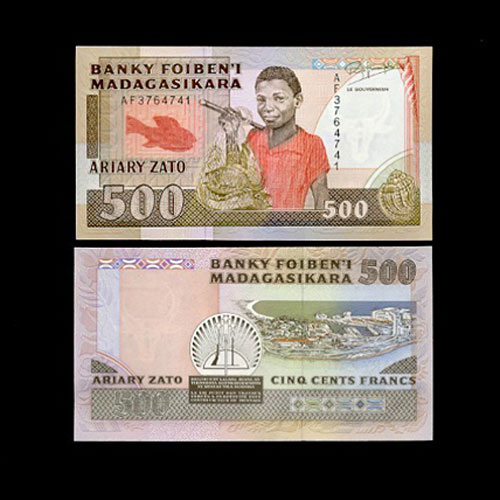Madagascar 100 Ariary banknote of 1988-93 series
2018-10-30 Tue
Madagascar is a huge island nation off the southeast coast of Africa. Madagascar is a biodiversity hotspot; over 90% of its wildlife is found nowhere else on Earth. It is home to thousands of animal species, such as lemurs, plus rainforests, beaches and reefs. Near the busy capital, Antananarivo, is Ambohimanga, a hillside complex of royal palaces and burial grounds, as well as the “Avenue of the Baobabs,” a dirt road lined by massive centuries-old trees.The island's diverse ecosystems and unique wildlife are threatened by the encroachment of the rapidly growing human population and other environmental threats. Ecotourism and agriculture are key elements of Madagascar's development strategy and the country belongs to the group of least developed countries, according to the United Nations. The main economic resources of Madagascar are tourism, textile export, production and export agricultural and mining.
The Ariary is the currency of Madagascar and it is subdivided into 5 iraimbilanja and is one of only two non-decimal currencies currently circulating. The names Ariary and Iraimbilanja derive from the pre-colonial currency, with ariary (from the Spanish word "real") being the name for a silver dollar. Iraimbilanja means literally "one iron weight" and was the name of an old coin worth 1?5 of an ariary.
In 1961, the Institut d’Emission Malgache (Malagasy Issuing Institute) introduced banknotes in denominations of 50, 100, 500, 1000 and 5000 francs. Today we are looking at a 100 Ariary banknote of 1988-93 series. The front of the note depicts a Malagasy boy with fish in the centre while the back features an aerial view of Port of Toamasina (Tamatave) along with a Watermark of Zebu's head.
Image Courtesy: Internumis
Latest News
-
Mahatma
2024-04-25 ThuIndia Post issued a commemorative postage stamp on #LalaHansraj, also known as Mahatma Hansraj for�...
-
Berar Mint of Muhammad Akbar
2024-04-25 ThuBerar was a kingdom located in the Deccan region, with Elichpur as its capital. It was one of the Su...
-
Janma Kalnayak of Bhagwan Mahavir
2024-04-24 WedOn 21st April 2024 which was the 2550th Janma Kalnyanak of Bhagwan Mahavir Swami, PM Modi unveile...
-
Gold Pagoda of Vijaynagar Empire King Deva Raya I
2024-04-10 WedKing Deva Raya I of the Vijayanagara Empire was a patron of Kannada literature and architecture. He ...
-
Silver Denarius of Septimus Severus
2024-04-05 FriLucius Septimius Severus served as the Roman emperor from 193 to 211 AD. Severus sat on the throne o...

